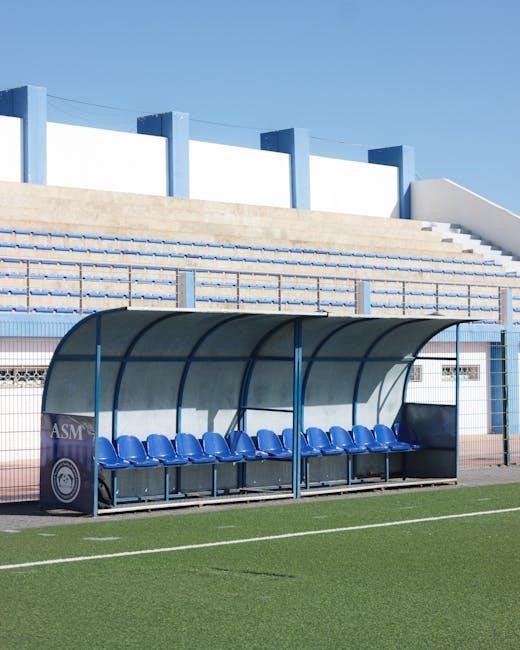The ASME BPVC PDF is a critical resource for regulating the design, construction, and safety of boilers and pressure vessels, ensuring compliance and operational safety across industries.
Overview of the ASME Boiler and Pressure Vessel Code
The ASME Boiler and Pressure Vessel Code (BPVC) is a comprehensive standard that regulates the design, construction, and operation of boilers and pressure vessels. It ensures safety, reliability, and compliance across various industries. The code covers power boilers, heating boilers, nuclear components, and pressure vessels, providing detailed guidelines for materials, fabrication, and inspection. Regularly updated, the BPVC incorporates advancements in technology and industry practices, making it a cornerstone for safe and efficient equipment operation worldwide.
Purpose and Scope of the BPVC
The ASME BPVC establishes safety standards for the design, construction, and operation of boilers and pressure vessels. Its scope covers power boilers, heating boilers, nuclear components, and pressure vessels, ensuring compliance with safety, efficiency, and regulatory requirements. The code applies across industries, including power generation, chemical plants, and nuclear energy. By providing detailed guidelines, it minimizes risks and ensures reliable performance, serving as a global benchmark for safeguarding public safety and environmental protection.

Key Sections of the ASME BPVC
The ASME BPVC comprises multiple sections regulating boilers, pressure vessels, materials, nuclear components, and nondestructive examination. Each section ensures safety, quality, and compliance in specific applications.
Section I: Power Boilers
Section I of the ASME BPVC focuses on power boilers, providing guidelines for the design, construction, and operation of boilers used in power generation. It covers materials, fabrication, and safety standards to ensure reliability and efficiency. The section emphasizes proper welding techniques, nondestructive testing, and compliance with pressure and temperature limits. Adhering to these standards minimizes risks and ensures operational safety in industrial and power plant settings, making it a cornerstone for boiler safety and performance in the energy sector.
Section II: Materials
Section II of the ASME BPVC focuses on material specifications for boilers and pressure vessels. It provides detailed requirements for ferrous and nonferrous materials, including mechanical properties, chemical composition, and testing standards. This section ensures that materials used in construction meet safety and performance criteria. It is divided into parts D (property tables) and parts A, B, and C (specific material specifications). Adherence to these guidelines ensures the structural integrity and reliability of components under various operating conditions.
Section III: Nuclear Components
Section III of the ASME BPVC addresses the design, fabrication, and inspection of nuclear components, ensuring their safety and reliability in nuclear power plants. It establishes strict guidelines for materials, welding, and nondestructive testing to meet the unique demands of nuclear applications. This section is critical for maintaining the structural integrity of components exposed to extreme conditions, ensuring compliance with nuclear safety standards and regulatory requirements. Its detailed specifications help prevent failures and enhance public safety.
Section IV: Heating Boilers
Section IV of the ASME BPVC focuses on the design, construction, installation, and operation of heating boilers. It provides guidelines for low-pressure steam and hot water boilers, ensuring safety and efficiency. This section covers requirements for materials, manufacturing, and safety standards, specifically tailored for heating applications. It includes rules for boilers used in heating systems, emphasizing proper installation, maintenance, and inspection to ensure reliability and compliance with safety protocols. Its provisions are essential for preventing failures and ensuring optimal performance in heating systems.
Section V: Nondestructive Examination
Section V of the ASME BPVC PDF focuses on nondestructive examination (NDE) methods for boilers and pressure vessels. It outlines techniques like ultrasonic testing, radiography, and magnetic particle testing to detect defects without damaging materials. This section ensures the integrity and reliability of components, providing detailed guidelines for proper testing procedures, personnel qualification, and equipment calibration. Compliance with Section V is essential for maintaining safety, preventing failures, and adhering to ASME standards in various industries.
Section VI: Recommended Guidelines for the Care of Power Boilers
Section VI provides detailed guidelines for the care of power boilers, focusing on maintenance, inspection, and operational best practices. It covers routine maintenance tasks, water treatment, and strategies for boiler lay-up during seasonal shutdowns. These recommendations aim to ensure optimal performance, extend equipment lifespan, and prevent potential failures. By following these guidelines, operators can maintain safety, efficiency, and compliance with ASME standards while minimizing downtime and environmental impact.
Section VII: Care of Power Boilers
Section VII focuses on the practical aspects of power boiler care, including startup, shutdown, and ongoing maintenance. It emphasizes water treatment, corrosion prevention, and inspection practices to ensure safe and efficient operation. This section provides actionable guidance for operators to maintain boiler integrity, prevent failures, and optimize performance. Adherence to these standards helps minimize downtime, reduce risks, and prolong the service life of power boilers, aligning with overall safety and operational goals.
Section VIII: Pressure Vessels
Section VIII provides detailed requirements for the design, materials, fabrication, inspection, and testing of pressure vessels. It ensures the safety and reliability of vessels operating under internal or external pressure. This section covers various types of pressure vessels, including cylindrical, spherical, and others, and outlines guidelines for nondestructive examination and certification. Compliance with Section VIII is critical for meeting safety standards and preventing failures in industrial applications, ensuring the integrity of pressure vessels across diverse industries.
Section IX: Welding and Brazing Qualifications
Section IX of the ASME BPVC PDF outlines the qualification requirements for welding and brazing procedures, personnel, and testing methods. It ensures that all welding and brazing activities meet specific safety standards. Compliance with Section IX is essential for maintaining the integrity of boilers and pressure vessels, reducing risks, and adhering to regulatory requirements.

Importance of Compliance with ASME BPVC
Compliance ensures safety, reduces risks, and meets legal standards. It protects people and the environment while avoiding penalties and enhancing operational efficiency and reliability.

Safety Standards and Risk Reduction
The ASME BPVC serves as a cornerstone for ensuring compliance with stringent safety standards across various industries. By providing detailed guidelines for boilers and pressure vessels, it minimizes potential hazards and enhances operational reliability. Compliance with these standards not only protects human life and the environment but also helps organizations avoid legal penalties. Adhering to the BPVC fosters a culture of safety and continuous improvement, which are essential for sustainable industrial operations.
Legal and Regulatory Requirements
Compliance with the ASME BPVC PDF is often mandated by law, ensuring adherence to established safety and design standards. Regulatory bodies worldwide recognize the BPVC as a benchmark for boilers and pressure vessels. Organizations must comply with these codes to avoid legal penalties and operate within jurisdictional requirements. The BPVC also supports accreditation processes, such as those overseen by the National Board of Boiler and Pressure Vessel Inspectors, ensuring legal and regulatory conformity across industries.
Economic Benefits of Compliance
Adhering to the ASME BPVC PDF ensures reduced operational risks, minimizing costly repairs and downtime. Compliance enhances efficiency, extends equipment lifespan, and lowers maintenance expenses. It also supports insurance premium reductions and fosters trust in organizational reliability. By meeting these standards, companies gain a competitive edge in global markets, avoiding financial penalties and reputational damage. Long-term profitability is achieved through sustainable, compliant practices that align with industry best standards and customer expectations.

Accessing and Using ASME BPVC PDF
The ASME BPVC PDF is available through official ASME channels, offering digital access to standards for boilers and pressure vessels. It features searchable content, bookmarks, and regular updates to ensure compliance with the latest industry requirements, enhancing user convenience and efficiency in applying the code.
How to Obtain the ASME BPVC PDF
The ASME BPVC PDF can be purchased directly from the ASME website or through authorized resellers. It is available as a digital download, requiring registration or subscription. Academic institutions and organizations may also provide access. Ensure compliance by obtaining the document from reputable sources, as unauthorized distribution is prohibited. Check with engineering departments or libraries for potential access through academic licenses, ensuring legal and secure acquisition of the PDF.
Navigating the Digital Version
The digital ASME BPVC PDF offers enhanced navigation tools, including a detailed index, bookmarks, and hyperlinked cross-references. Users can quickly search for specific sections or keywords using built-in search functionality. The format is optimized for readability on computers, tablets, and smartphones, ensuring accessibility across devices. Annotations and highlighting features allow for personalized notes, improving study and reference efficiency. Regular updates ensure users have the most current standards and guidelines at their fingertips, streamlining compliance and application.
Updates and Revisions
The ASME BPVC PDF undergoes regular updates to reflect advancements in technology, materials, and industry practices. These revisions ensure the code remains relevant and aligns with current safety and design standards. Updates are typically published annually and include changes to specific sections, such as new materials, revised testing methods, or enhanced safety protocols. Users are encouraged to check for the latest version through official ASME channels to ensure compliance and access the most accurate guidelines.

Historical Development and Evolution
The ASME BPVC PDF originated from the need for standardized safety protocols in the early 20th century, evolving into a comprehensive guide for boiler and pressure vessel design, construction, and operation. Initially published in 1915, it has grown to address technological advancements, new materials, and lessons learned from historical incidents, ensuring safer and more reliable equipment worldwide. Its development reflects continuous improvements in engineering practices and regulatory requirements.
History of the ASME BPVC
The ASME Boiler and Pressure Vessel Code (BPVC) was first published in 1915, born out of the need for standardized safety protocols for boilers and pressure vessels. Over the years, it has evolved to address technological advancements, new materials, and lessons learned from historical incidents. The code has grown from a basic guide to a comprehensive resource, incorporating updates and revisions to ensure alignment with modern engineering practices and safety standards. Its development reflects a commitment to protecting people and property while fostering innovation in design and construction.
Recent Updates and Revisions
Recent updates to the ASME BPVC reflect advancements in materials science, digital technologies, and safety standards. The 2023 edition introduced revised guidelines for nondestructive examination and enhanced criteria for nuclear components. Updates in 2025 focused on incorporating new materials and improving digital integration for better accessibility. These revisions ensure the code remains aligned with industry needs, addressing emerging challenges while maintaining its core commitment to safety and reliability in boiler and pressure vessel design and operation.

Industry Applications and Use Cases
The ASME BPVC PDF is essential for power generation, chemical plants, and nuclear energy, ensuring safety and compliance in critical industrial operations and equipment design.
Power Generation and Distribution
The ASME BPVC PDF plays a pivotal role in ensuring the safety and efficiency of power generation systems, including boilers and pressure vessels in fossil fuel and nuclear plants. These guidelines are crucial for maintaining operational integrity, preventing failures, and ensuring reliable energy distribution. Compliance with the BPVC standards is essential for safeguarding both personnel and the environment, particularly in high-stakes power generation environments where any malfunction could have catastrophic consequences.
Chemical and Petrochemical Plants
The ASME BPVC PDF is indispensable in the chemical and petrochemical industries, providing critical guidelines for the safe design, construction, and operation of boilers, pressure vessels, and piping systems. Compliance with these standards ensures the integrity of reactors, storage tanks, and other equipment, minimizing the risk of hazardous incidents. Adherence to BPVC requirements is essential for maintaining operational stability, protecting personnel, and preventing environmental hazards in these high-risk industrial settings.
Nuclear Energy Applications
The ASME BPVC PDF plays a pivotal role in nuclear energy applications, ensuring the safe design, construction, and operation of nuclear components and systems. Section III of the BPVC specifically addresses nuclear facilities, providing stringent guidelines to mitigate risks and ensure compliance with international safety standards. Adherence to these codes is critical for maintaining the integrity of reactors, piping, and storage systems, thereby safeguarding public health and the environment from potential nuclear hazards. Regular updates ensure alignment with advancing technologies and safety protocols.

Getting Started with ASME BPVC
Begin by accessing the ASME BPVC PDF, understanding its structure, and leveraging official training resources to ensure compliance and safe implementation of boiler and pressure vessel standards.
Training and Resources
Comprehensive training programs, workshops, and online courses are available to help professionals understand and implement ASME BPVC standards effectively. These resources cover design, construction, and safety protocols, ensuring compliance. Official ASME publications, including the BPVC PDF, provide detailed guidelines and updates. Additionally, digital tools and reference materials support ongoing education and adherence to industry best practices, making it easier for engineers and organizations to stay informed and up-to-date with the latest standards and technological advancements.
Best Practices for Implementation
Implementing ASME BPVC requires adherence to established guidelines, regular updates, and thorough documentation. Best practices include conducting routine inspections, ensuring compliance with safety standards, and staying informed about code revisions. Organizations should prioritize training employees and maintaining detailed records of compliance activities. By integrating these practices, companies can enhance operational safety, reduce risks, and ensure long-term adherence to regulatory requirements.

Role of the National Board in BPVC Accreditation
The National Board oversees BPVC accreditation, ensuring compliance with safety standards and promoting public safety through rigorous inspections and certifications for boilers and pressure vessels.
National Board of Boiler and Pressure Vessel Inspectors
The National Board of Boiler and Pressure Vessel Inspectors ensures compliance with ASME BPVC standards through accreditation and certification programs, promoting public safety and industry reliability.
Accreditation Process
The accreditation process involves rigorous audits and evaluations to ensure organizations meet ASME BPVC standards. It includes document reviews, facility inspections, and staff qualifications. Certification is granted upon successful completion, with periodic recertification to maintain compliance. This process ensures high-quality standards are upheld, promoting safety and reliability in boiler and pressure vessel operations across industries.

Future of ASME BPVC
The ASME BPVC will continue evolving with technological advancements, integrating new materials and digital solutions to enhance safety and efficiency in boiler and pressure vessel standards.
Technological Advancements and Their Impact
Technological advancements are reshaping the ASME BPVC, driving innovation in materials, design, and inspection methods. New materials and digital tools enhance safety and efficiency, while simulation software improves design accuracy. The integration of automation and IoT enables real-time monitoring of boilers and pressure vessels, reducing risks. These advancements ensure the BPVC remains relevant, adapting to modern engineering challenges and supporting sustainable practices in industries worldwide.
Evolution of Standards
The ASME BPVC standards have evolved significantly over the years, with continuous updates to address emerging technologies and industry needs. The code now incorporates advanced materials, digital tools, and innovative construction methods. It aligns with global safety standards, ensuring harmonization and compliance. Regular revisions reflect lessons learned from real-world applications, enhancing reliability and safety. This evolution underscores the BPVC’s commitment to staying at the forefront of engineering and safety practices.


